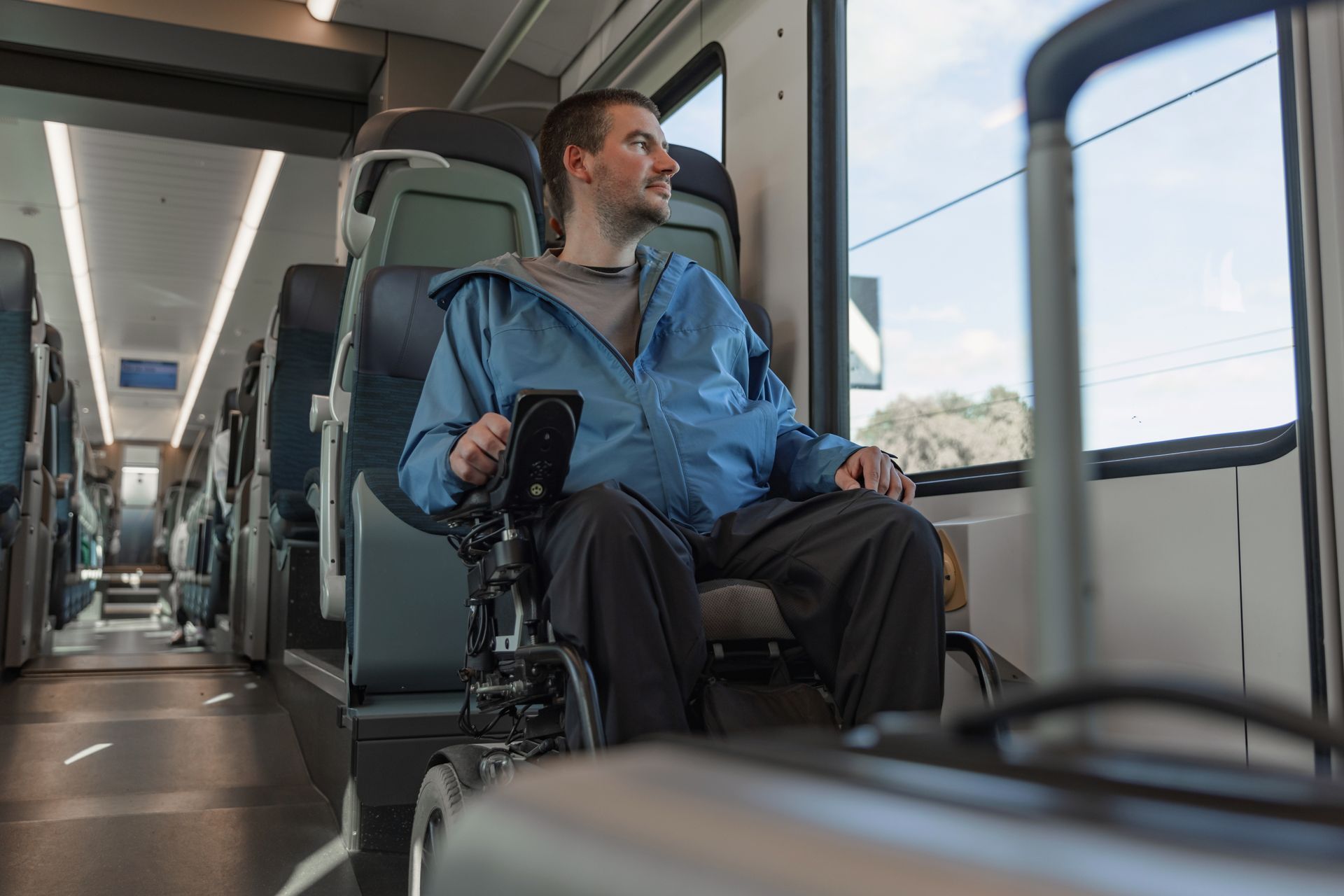Discovering Europe: A Guide to Summer Solo Travel for Handicapped Explorers
Allstop Travel
Embracing Summer Solo Travel

lEmbarking on summer solo travel is both exciting and rewarding, particularly for those eager to explore Europe independently. This section offers insights into how to prepare for your journey while ensuring comfort and accessibility. With thoughtful planning, you can embrace the freedom and adventure of solo travel.
Preparing for Your Journey:
Preparing for a solo travel adventure involves research and planning tailored to your unique needs. At Allstop Travel we are experienced with the challenges that handicaps present. Let us help you in exploring the world in new ways you might never have thought possible. If you decide to "Go it" Truley SOLO I hope this blog helps you have the trip you have always dreamed.
Start by exploring tips for travelers with disabilities. Gather information about destinations, accessibility, and potential challenges. A well-researched itinerary ensures a smoother experience.
Next, consult resources like Reddit's solo travel community for firsthand accounts. Reading about others' experiences provides valuable insights and often overlooked details. Engaging with these communities can also offer personal support.
Finally, ensure you have all necessary documentation, such as medical records and personal identification. Having these readily available aids in emergencies or unexpected situations. It's also wise to inform someone back home of your travel plans and contact information.
Packing Essentials for Comfort:
Packing for comfort is key to ensuring a pleasant journey. Prioritize items that enhance comfort and accessibility. Start with lightweight, adaptable clothing suitable for various climates and activities.
Next, consider mobility aids and accessories that facilitate easier travel. Items like portable ramps or foldable canes can be invaluable. Able Amsterdam's tips offer practical advice on selecting travel-friendly aids.
Additionally, pack essential medications and a first-aid kit, tailored to your specific needs. Ensure you have enough supplies for the entire trip, plus a little extra for unforeseen delays. This preparation provides peace of mind and reduces stress.
Planning Accessible Travel Routes:
Planning accessible travel routes involves understanding transportation options and their accessibility. Start by researching public transport systems and services. Websites like Quora offer advice on navigating Europe's diverse transport networks.
When planning routes, identify stations and stops with accessibility features. This includes elevators, ramps, and designated seating areas. Also, consider alternative transport methods like accessible taxis or ride-sharing services.
Lastly, create a flexible itinerary that accommodates changes or unforeseen obstacles. Allow additional time for travel, ensuring a relaxed pace. Flexibility enhances your experience and reduces stress during your journey.
Exploring Accessible Travel Europe: Europe offers a wealth of disability-friendly destinations, making it an ideal choice for solo travelers. This section explores top destinations, public transport navigation, and finding suitable accommodations. Embrace Europe's accessible travel options to enhance your adventure.
Top Disability-Friendly Destinations:
Exploring disability-friendly destinations enriches your travel experience. Europe boasts numerous welcoming cities, each offering unique attractions and amenities. Start with cities like
Amsterdam, Barcelona, and Berlin, known for their accessibility features.
Amsterdam, renowned for its inclusive infrastructure, offers attractions like the Van Gogh Museum with accessible facilities. Similarly, Barcelona's public transport and pedestrian zones cater to all travelers. Berlin, with its rich history, also provides ample accessible options.
Consider visiting lesser-known destinations like
Ljubljana, Slovenia, or Malmö, Sweden. These cities prioritize accessibility and offer a quieter, more relaxed atmosphere. Exploring diverse locations adds depth to your adventure.
Navigating Public Transport:
Navigating public transport is crucial for accessible travel in Europe. Begin by understanding the local systems, including bus, tram, and train networks. Each city offers unique services, so familiarize yourself with their specific features.
Utilize resources such as Rick Steves' travel tips for insights on accessible transport. These tips provide practical advice on ticketing, boarding, and navigating stations.
Incorporate travel apps and tools to aid in real-time navigation. Apps like Google Maps offer accessibility options, including step-free routes and detailed transit information. Leveraging technology enhances your travel efficiency and experience.
Finding Handicap Accessible Europe Accommodations:
Finding suitable accommodations is essential for a comfortable stay. Begin by researching hotels and rentals that prioritize accessibility. Look for features like step-free entrances, accessible bathrooms, and mobility-friendly layouts.
Consult online resources like Able Amsterdam which provide recommendations and reviews. These insights help identify accommodations that meet your specific needs.
Lastly, contact potential accommodations directly to confirm accessibility features. Discuss any additional requirements you may have. Direct communication ensures your stay is enjoyable and stress-free.
Making the Most of Solo Travel Experiences:
Solo travel offers unparalleled opportunities for personal growth and discovery. This section highlights ways to connect with local communities, savor cultural experiences, and join guided tours. Maximize your solo travel experiences with these tips.
Connecting with Local Communities:
Connecting with local communities enriches your travel experience. Engaging with residents offers authentic insights into the culture and lifestyle. Start by participating in community events or local gatherings.
Volunteering or joining interest-based groups provides meaningful interactions. These experiences foster genuine connections and enhance your understanding of the local culture.
Utilize social media and travel forums to arrange meet-ups or activities with locals. Platforms like Meetup or Couchsurfing facilitate connections based on shared interests. Engaging with locals adds depth to your journey.
Savoring Cultural Experiences Safely:
Savoring cultural experiences safely involves understanding local customs and practices. Begin by researching cultural norms, including dress codes and etiquette. Respecting local traditions enhances your interactions and experiences.
Participate in accessible cultural events such as festivals, concerts, or exhibitions. Ensure these venues offer necessary accommodations for your needs.
Finally, prioritize safety by staying informed about local conditions and advisories. Maintain awareness of your surroundings and practice common-sense precautions. Safe exploration ensures a fulfilling and enjoyable cultural experience.
Joining Guided Tours and Activities:
Joining guided tours and activities offers structured exploration with added benefits.
Choose tours designed for accessibility, ensuring a comfortable experience. These tours often provide expert guides knowledgeable about local history and culture.
Explore options like audio-guided tours or virtual experiences.
These alternatives offer flexibility and accessibility, allowing you to engage with attractions at your own pace.
Tours and activities offer:
Structured itinerary and schedule, reducing planning stress.
Expert insights and historical context enhancing your experience.
Opportunities to meet fellow travelers, fostering community and connection.
Guided tours and activities enrich your solo travel experience by offering convenience, insight, and camaraderie.

💀 The Meaning Behind the Marigolds Each November 1–2, Mexico blooms with cempasúchil (marigolds), flickering candles, and music as families gather to honor loved ones. Día de los Muertos — the Day of the Dead — is a celebration of life remembered, not death mourned. Ancient Aztec beliefs combine with Catholic All Saints’ and All Souls’ Days to create a joyful ritual of reunion. Altars (ofrendas) overflow with flowers, favorite foods, and photos, inviting spirits to return for one more night of laughter and light. 🌆 Where to Experience Día de los Muertos 🕯 Oaxaca Watch candlelit parades, sand art, and brass bands weave through cobblestone streets in one of Mexico’s most traditional observances. 🎉 Mexico City The capital’s Mega Desfile (Grand Parade) dazzles with floats and costumes that inspired the Pixar film Coco. 🌊 Pátzcuaro, Michoacán Witness island vigils on Lake Pátzcuaro as candlelight dances across the water from Janitzio. ☀️ Riviera Maya & Cozumel Combine culture and relaxation — from resort-hosted workshops on skull painting to ancient Maya rituals honoring ancestors by the sea. 🎭 How to Celebrate Respectfully Observe gently: Ask permission before photographing altars or ceremonies. Shop local: Choose hand-painted skulls and embroidered textiles crafted by Indigenous artists. Taste tradition: Try pan de Muerto and atole from neighborhood bakeries. Join with heart: Many communities welcome visitors into parades and public celebrations — listen, learn, and celebrate with respect. 🌺 Why Travel in Early November November brings mild weather, smaller crowds, and authentic connection before peak winter season. Whether strolling through Oaxaca’s candlelit streets or relaxing seaside after a festival in Playa del Carmen, this is Mexico at its most colorful and heartfelt.

Creating a Family History Book One meaningful way to preserve your findings is by creating a family history book. This can be both a personal project and a treasure for your family. Here’s a quick guide on how to get started: Organizing Content: Begin by outlining the main sections of your book. These could include family tree charts, biographies, significant events, and ancestral town histories. Writing Narratives: Turn the data into engaging stories. Share anecdotes, cultural practices, and how historical events shaped your family’s journey. Incorporating Visuals: Integrate photographs, scanned documents, and maps to bring your narrative to life. Design and Format: Utilize online tools or professional services to format your book. Pay attention to layout and readability to make it visually appealing. Printing and Distribution: Decide whether you want to self-publish or use a print-on-demand service. Share copies with family members to ensure the legacy is preserved. Engaging the Younger Generation To ensure your family’s heritage continues to be celebrated, engage the younger generation. Here are some creative ideas: Interactive Family Tree Projects: Use digital tools to create an interactive family tree where younger family members can explore their ancestry. Storytelling Sessions: Host family gatherings where stories are shared. Encourage younger members to ask questions and share their thoughts on family history. Heritage Tours: Plan a family trip to ancestral towns. Experiencing the places firsthand can foster a deeper appreciation for their heritage. Hosting a Family Reunion Consider organizing a family reunion centered around your genealogy discoveries. This event can be an opportunity to reunite family members from various branches and celebrate your shared history. Plan activities that highlight your research, such as: Genealogy Workshops: Offer sessions where you can teach others how to start or continue their research. Cultural Activities: Include traditional food, music, or games that reflect your German heritage. Presentation of Your Findings: Share a presentation of your research, featuring stories, photos, and any surprises uncovered along the way. What’s Next in Your Ancestry Journey? Your genealogical research journey doesn't have to end here. There are endless possibilities to explore further: Exploring Other Lineages: If you have multiple ethnic backgrounds, consider researching other branches of your family tree. Documenting Oral Histories: Continue collecting stories and memories from older family members. Document these to preserve living history. Advancing Your Skills: Attend genealogy conferences or online courses to refine your research techniques. Continuing the Legacy As you reflect on your journey into your German ancestry, remember that genealogy is more than just names and dates. It's about the stories, the connections, and the legacy you build for future generations. Keep the curiosity alive, and let each new discovery deepen your appreciation for your family's unique story.

